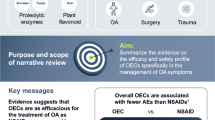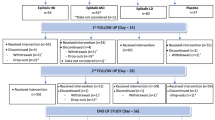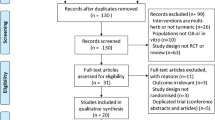Abstract
Introduction
Flavocoxid is a novel flavonoid-based “dual inhibitor” of the 5-lipoxygenase (5-LOX) enzyme and the cyclooxygenase (COX) enzymes. This study was designed to compare the effectiveness and safety of flavocoxid to naproxen in subjects with moderate to severe osteoarthritis (OA) of the knee.
Methods
In this randomized, multicenter, double-blind study, 220 subjects were assigned to receive either flavocoxid (500 mg twice daily) or naproxen (500 mg twice daily) for 12 weeks. The trial was structured to show noninferiority of flavocoxid to naproxen. Primary outcome measures included the Western Ontario and McMaster Universities Osteoarthritis Index (WOMAC) and subscales and a timed walk.
Results
More than 90% of the subjects in both groups noted significant reduction in the signs and symptoms of knee OA. There were no statistically significant differences in efficacy between the flavocoxid and naproxen groups when the entire intent-to-treat population was analyzed. The flavocoxid group had significantly fewer upper gastrointestinal (UGI) and renal (edema) adverse events (AEs) as well as a strong trend toward fewer respiratory AEs.
Conclusion
Flavocoxid, a first-in-class flavonoid-based therapeutic that inhibits COX-1 and COX-2 as well as 5-LOX, was as effective as naproxen in managing the signs and symptoms of OA of the knee. Flavocoxid demonstrated better UGI, renal (edema), and respiratory safety profiles than naproxen.
Similar content being viewed by others
References
Lawrence RC, Felson DT, Helmick CG, et al. Estimates of the prevalence of arthritis and other rheumatic conditions in the United States. Part II. Arthritis Rheum. 2008;58:26–35.
Andersen RE, Crespo CJ, Ling SM, Bathon JM, Bartlett SJ. Prevalence of significant knee pain among older Americans: results from the Third National Health and Nutrition Examination Survey. J Am Geriatr Soc. 1999;47:1435–1438.
Dillon CF, Rasch EK, Gu Q, Hirsch R. Prevalence of knee osteoarthritis in the United States: arthritis data from the Third National Health and Nutrition Examination Survey 1991-94. J Rheumatol. 2006;33:2271–2279.
Grotle M, Hagen KB, Natvig B, Dahl FA, Kvien TK. Prevalence and burden of osteoarthritis: results from a population survey in Norway. J Rheumatol. 2008;35:677–684.
Woolf AD, Pfleger B. Burden of major musculoskeletal conditions. Bull World Health Organ. 2003;81:646–656.
Sale JE, Gignac M, Hawker G. The relationship between disease symptoms, life events, coping and treatment, and depression among older adults with osteoarthritis. J Rheumatol. 2008;35:335–342.
Salaffi F, Carotti M, Stancati A, Grassi W. Health-related quality of life in older adults with symptomatic hip and knee osteoarthritis: a comparison with matched healthy controls. Aging Clin Exp Res. 2005;17:255–263.
Jinks C, Jordan K, Croft P. Osteoarthritis as a public health problem: the impact of developing knee pain on physical function in adults living in the community: (KNEST 3). Rheumatology (Oxford). 2007;46:877–881.
Ethgen O, Vanparijs P, Delhalle S, Rosant S, Bruyere O, Reginster JY. Social support and health-related quality of life in hip and knee osteoarthritis. Qual Life Res. 2004;13:321–330.
Kirchner T, Aparicio B, Argentieri DC, Lau CY, Ritchie DM. Effects of tepoxalin, a dual inhibitor of cyclooxygenase/5-lipoxygenase, on events associated with NSAID-induced gastrointestinal inflammation. Prostaglandins Leukot Essent Fatty Acids. 1997;56:417–423.
Dannhardt G, Kiefer W. Cyclooxygenase inhibitors — current status and future prospects. Eur J Med Chem. 2001;36:109–126.
Burnett BP, Levy R, Cole BJ. Metabolic mechanisms in the pathogenesis of osteoarthritis. A review. J Knee Surg. 2006;19:191–197.
Martel-Pelletier J, Mineau F, Fahmi H, et al. Regulation of the expression of 5-lipoxygenaseactivating protein/5-lipoxygenase and the synthesis of leukotriene B(4) in osteoarthritic chondrocytes: role of transforming growth factor beta and eicosanoids. Arthritis Rheum. 2004;50:3925–3933.
Brune K. Safety of anti-inflammatory treatment — new ways of thinking. Rheumatology (Oxford). 2004;43(suppl. 1):i16–20.
Hudson N, Balsitis M, Everitt S, Hawkey CJ. Enhanced gastric mucosal leukotriene B4 synthesis in patients taking non-steroidal anti-inflammatory drugs. Gut. 1993;34:742–747.
Antman EM, DeMets D, Loscalzo J. Cyclooxygenase inhibition and cardiovascular risk. Circulation. 2005;112:759–770.
Carmichael J, Shankel SW. Effects of nonsteroidal anti-inflammatory drugs on prostaglandins and renal function. Am J Med. 1985;78:992–1000.
Deray G. Renal and cardiovascular effects of nonsteroidal anti-inflammatories and selective cox 2 inhibitors. Presse Med. 2004;33:483–489.
Salahudeen AK, Reckelhoff JF, Morrow JD, Roberts LJ, 2nd. F2-isoprostanes and the kidney. Drug News Perspect. 1998;11:287–290.
Roberts L, Morrow J. The generation and actions of isoprostanes. Biochim Biophys Acta. 1997;1345:121–135.
Basu S, Whiteman M, Mattey DL, Halliwell B. Raised levels of F(2)-isoprostanes and prostaglandin F(2alpha) in different rheumatic diseases. Ann Rheum Dis. 2001;60:627–631.
Bombardier C, Laine L, Reicin A, et al. Comparison of upper gastrointestinal toxicity of rofecoxib and naproxen in patients with rheumatoid arthritis. VIGOR Study Group. N Engl J Med. 2000;343:1520–1528.
Silverstein FE, Faich G, Goldstein JL, et al. Gastrointestinal toxicity with celecoxib vs nonsteroidal anti-inflammatory drugs for osteoarthritis and rheumatoid arthritis: the CLASS study: a randomized controlled trial. Celecoxib Long-term Arthritis Safety Study. JAMA. 2000;284:1247–1255.
Fiorucci S, Santucci L, Wallace JL, et. al. Interaction of a selective cyclooxygenase-2 inhibitor with aspirin and NO-releasing aspirin in the human gastric mucosa. Proc Natl Acad Sci USA. 2003;100:10937–10941.
Eisen G. Lack of correspondence of risk factors and clinical GI outcomes for patients on nonsteroidal anti-inflammatory drugs (NSAIDs): analysis from the Celecoxib Long-term Arthritis Safety Study (CLASS). Gasteroenterology. 2001;120:A553.
Kulkarni SK, Singh VP. Licofelone: the answer to unmet needs in osteoarthritis therapy? Curr Rheumatol Rep. 2008;10:43–48.
Cicero AF, Derosa G, Gaddi A. Combined lipoxygenase/cyclo-oxygenase inhibition in the elderly: the example of licofelone. Drugs Aging. 2005;22:393–403.
Bertolini A, Ottani A, Sandrini M. Dual acting antiinflammatory drugs: a reappraisal. Pharmacol Res. 2001;44:437–450.
Altavilla D, Squadrito F, Bitto A, et al. Flavocoxid, a dual inhibitor of cyclooxygenase and 5-lipoxygenase, blunts pro-inflammatory phenotype activation in endotoxin stimulated macrophages. Brit J Pharmacol. 2009;157:1410–1418.
Burnett BP, Jia Q, Zhao Y, Levy RM. A medicinal extract of Scutellaria baicalensis and Acacia catechu acts as a dual inhibitor of cyclooxygenase and 5-lipoxygenase to reduce inflammation. J Med Food. 2007;10:442–451.
Burnett BP, Pillai L, Levy RM, editors. Flavocoxid, a natural novel flavonoid-based anti-inflammatory with a broad mechanism of action provides safe and effective inflammatory management of disease. Presented at: Society for Biomolecular Science; April 11–15, 2010; Phoenix, AZ.
Cao GH, Prior RL. Measurement of oxygen radical absorbance capacity in biological samples. Methods Enzymol. 1999;299:50–62.
Morgan SL, Baggott JE, Moreland L, Desomond R, Kendrach A. The safety of flavocoxid, a medical food, in the dietary management of knee osteoarthritis. J Medicinal Foods. 2008;12:1–6.
Levy R, Saikovsky R, Shmidt E, Khokhlov A, Burnett BP. Flavocoxid is as effective as naproxen for managing the signs and symptoms of osteoarthritis of the knee in humans: a short-term randomized, double-blind pilot study. Nutrition Res. 2009;29:298–304.
Burnett BP, Silva S, Mesches MH, Jia Q. Safety evaluation of a combination, defined extract of Scutellaria baicalensis and Acacia catechu. J Food Biochem. 2007;31:797–825.
Baron G, Tubach F, Ravaud P, Logeart I, Dougados M. Validation of a short form of the Western Ontario and McMaster Universities Osteoarthritis Index function subscale in hip and knee osteoarthritis. Arthritis Rheum. 2007;57:633–638.
Wolfe F. Determinants of WOMAC function, pain and stiffness scores: evidence for the role of low back pain, symptom counts, fatigue and depression in osteoarthritis, rheumatoid arthritis and fibromyalgia. Rheumatology (Oxford). 1999;38:355–361.
Jinks C, Jordan K, Croft P. Measuring the population impact of knee pain and disability with the Western Ontario and McMaster Universities Osteoarthritis Index (WOMAC). Pain. 2002;100:55–64.
Shapiro SS, Wilk MB. An analysis of variance test for normality (complete samples). Biometrika. 1965;52:591–511.
Bertolini A, Ottani A, Sandrini M. Dual acting antiinflammatory drugs: a reappraisal. Pharmacol Res. 2001;44:437–450.
Pelletier JP, Martel-Pelletier J, Raynauld JP. Most recent developments in strategies to reduce the progression of structural changes in osteoarthritis: today and tomorrow. Arthritis Res Ther. 2006;8:206.
Naftalin RJ, Afzal I, Cunningham P, et al. Interactions of androgens, green tea catechins and the antiandrogen flutamide with the external glucose-binding site of the human erythrocyte glucose transporter GLUT1. Br J Pharmacol. 2003;140:487–499.
Fiorani M, Accorsi A, Cantoni O. Human red blood cells as a natural flavonoid reservoir. Free Radic Res. 2003;37:1331–1338.
Hudson N, Balsitis M, Everitt S, Hawkey CJ. Enhanced gastric mucosal leukotriene B4 synthesis in patients taking non-steroidal anti-inflammatory drugs. Gut. 1993;34:742–747.
Badr KF. Five-lipoxygenase products in glomerular immune injury. J Am Soc Nephrol. 1992;3:907–915.
Pretorius JC. Flavonoids: a review of its commercial application potential as anti-infective agents. Curr Med Chem. 2003;2:335–353.
Yamada H, Takuma N, Daimon T, Hara Y. Gargling with tea catechin extracts for the prevention of influenza infection in elderly nursing home residents: a prospective clinical study. J Altern Complement Med. 2006;12:669–672.
Manoukian AV, Carson JL. Nonsteroidal antiinflammatory drug-induced hepatic disorders. Incidence and prevention. Drug Saf. 1996;15:64–71.
Walker AM. Quantitative studies of the risk of serious hepatic injury in persons using nonsteroidal antiinflammatory drugs. Arthritis Rheum. 1997;40:201–208.
Alatalo PI, Koivisto HM, Hietala JP, Puukka KS, Bloigu R, Niemela OJ. Effect of moderate alcohol consumption on liver enzymes increases with increasing body mass index. Am J Clin Nutr. 2008;88:1097–1103.
Author information
Authors and Affiliations
Corresponding author
Rights and permissions
About this article
Cite this article
Levy, R.M., Khokhlov, A., Kopenkin, S. et al. Efficacy and safety of flavocoxid, a novel therapeutic, compared with naproxen: a randomized multicenter controlled trial in subjects with osteoarthritis of the knee. Adv Therapy 27, 731–742 (2010). https://doi.org/10.1007/s12325-010-0064-z
Received:
Published:
Issue Date:
DOI: https://doi.org/10.1007/s12325-010-0064-z




